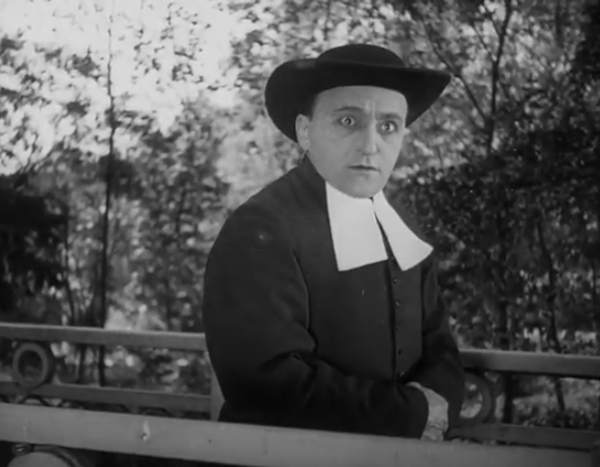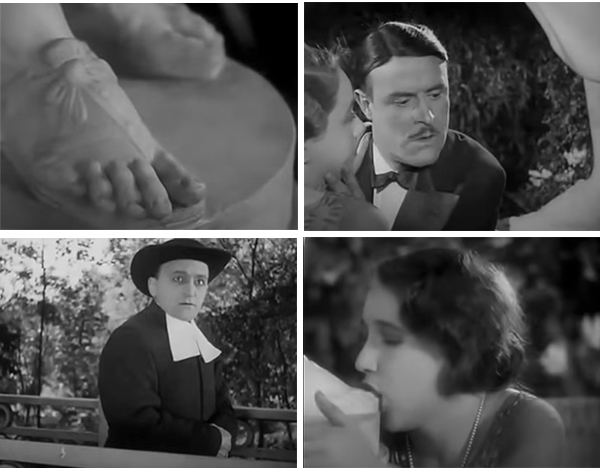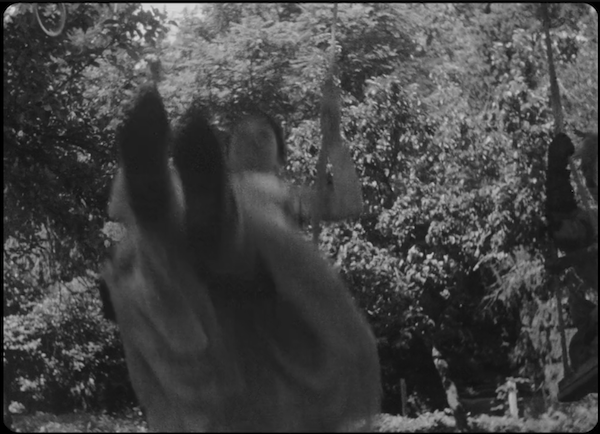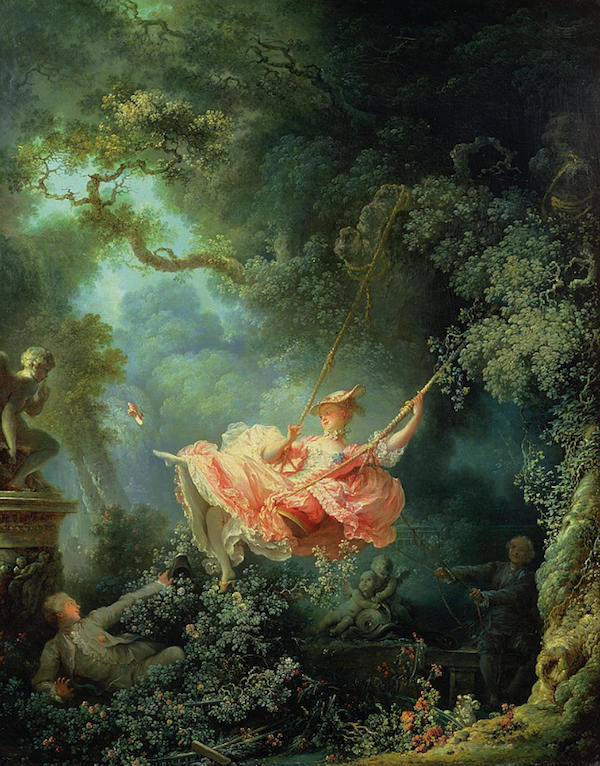On a connection between Bunuel's L'Age d'Or and Renoir's A Day in the Country
An association of priests
 From L'Age d'Or
From L'Age d'Or
My son, Aaron, was wanting to discuss with me my thoughts on Luis Bunuel's 1930 L'Age d'Or, which I'd not watched in a while and I promised to check it out again.
For more than several days he had also been periodically discussing Jean Renoir's 1936 film, A Day in the Country, which was based on a Guy de Maupassant story. Sylvia Maklès, Georges Bataille's wife (they were by then separated) stars. My son was interested in the fact that Georges Bataille makes a brief appearance in the movie as one of three seminarians, accompanied by a priest, who see a mother and daughter swinging, pause to ogle the scene for a second, then are hurried along by the priest. Another one of the seminarians is Henri Cartier-Bresson, who was acting as second assistant director. Pierre Lestringuez is the priest who propels the priests-in-training along when the secular world attracts them. Jacques Becker, the assistant director who finished filming after the production was shut down for a time and Renoir was then disengaged as he had to prepare for another film, is given on IMDB as a third seminarian, but the man who walks alongside Lestringuez is much older and heavier, it's not a match.
I thought I was familiar with that movie but it turned out I wasn't, I'd confused it with another, so I watched it as well and was surprised to find that the Renoir film seems to reference the Bunuel film.
In L'Age d'Or, as Lya Lys and Gaston Modot make out in a garden to an orchestra playing Wagner's "Liebestod" from Tristan and Isolde, he stops to stare at the big toe of a statue next to them. While Gaston intently concentrates on the toe, Bunuel crossfades to four priests progressing, one by one, over a bridge. The last stopping to stare in astonishment at the camera, the impression is given that he has seen the pair in the garden, which causes him to turn back, but he is also the same violinist priest who is observed in the orchestra, and of whom Lya Lys had briefly spoken about earlier in the day as being a good violinist, the monologue in which this occurs being a peculiar one on the orchestra employed for that night and how sound gets lost in the open air but they will be using a microphone. After the priest turns back on the bridge, we are returned to Lya and Gaston as he finishes his intent concentration on the toe and they continue their lovemaking. They are then interrupted with a message for Gaston that the Minister of the Interior is on the phone. He leaves Lya to attend to the call, and while she waits she at first rather absent-mindedly, then intently, begins to suck upon the statue's toe. This can be taken as a distracted release of sexual tension, the two continually interrupted in their lovemaking, but there is considerable drama that occurs surrounding this, in this section commented upon by Wagner's love-death music, and the scenes have to be considered in context of the whole.
 From A Day in the Country, Bataille is screen right
From A Day in the Country, Bataille is screen right
 Condensed order of events in L'Age d'Or
Condensed order of events in L'Age d'Or
The priests crossing over the bridge, one turning back, in the Bunuel film, is going to connect with the ending in which Duc de Blangis, accompanied by three other libertines, emerges from the castle of orgies in the Marquis de Sade's 120 Days of Sodom and the four cross over its drawbridge to return to society. In the film, De Blangis, dressed as a bearded monk or Christ, turns back when a distressed young woman, covered in blood, emerges from the castle. Consoling, he crosses back over the drawbridge and enters the castle with her. We hear a scream, then he appears again, his beard now gone, and continues on. Text preceding states the situation of De Blangis and the others, but doesn't comment on what transpires with the young woman. It is stated the libertines brutally used the girls they took with them to the castle. "To them the life of a woman mattered no more than a fly." End film on a cross decorated with scalps. Many assume they represent the female victims, but the aristocrats wear wigs with long hair, and De Blangis is repreented as having long hair.
L'Age d'Or was financed by Vicomte Charles de Noailles as a birthday gift for his wife, Vicomtesse Marie-Laure de Noailles, both ardent patrons of the surrealists, and Marie-Laure the great-great-great granddaughter of the Marquis de Sade, so that the coda is distinguished to clearly remark upon De Sade needs to be considered in light of who had commissioned it, who were its financiers. Inarguably, the film was transgressive, anti-church, critical of the bourgeoise, these are easy take-aways, but exactly what all the particulars meant was a matter of debate, it since being described by commenters as having something something to do with two lovers being thwarted in their lovemaking by society, state and church. The broad strokes may seem evident but are complicated by details that will be endlessly interrogated for meaning, which is all right that they are picked apart, and all right that they conjure multiple interpretations. I find that Moviediva has noted that the premiere showing was accompanied by a 24 page program of writings by Bunuel and Éluard, and one wonders about the choices that were made as to content and how it might relate to the film. I wish I had a glimpse of that booklet.
It's hard to debate the meaning of a thing that isn't even available for viewing, and for many years the film wasn't accessible. Premiered on 29 November 1930, the reaction against the film was so violent that it was banned in France on 10 December, 1930, and the de Noailles family withdrew it from commercial distribution. So Renoir is referencing a film that may have been infamous, but the majority who saw A Day in the Country would have never seen L'Age d'Or and would have no way of seeing it.
I checked the Guy de Maupassant story to see if the parade of the seminarians with the priest appears in it, which it does not. That section of the story is only concerned with two boatmen watching mother and daughter on the swings. One of the boatmen eventually makes love to the daughter, played by Sylvia Maklès. His name is Henri, her name is Henriette, the implication being that they belong together, the masculine and feminine halves of a whole. But Henri is of a lower class. Henriette returns to her life and marries as she is expected to do, to whom she is expected to marry. Later, she and her husband visit the island where she and Henri had made love, and she briefly runs into him. The de Maupassant story is on the sexual awakening of a young woman during a chance meeting, her senses also enflamed by her proximity to nature, and of two people who long for one another but are kept apart by their stations in life. In the Renoir film, though we feel Henriette desires Henri, she is just as much perhaps opposed to having sex with him, this man she's just met and who she knows will never be part of her life. She does at one point eagerly kiss him, but she turns her face to the camera as they make love, and she's crying. I don't think it's a matter of rape, but more indecisiveness, the uncertainty and fear of this being her first sexual experience, and treading on this dangerous ground emotionally of being with someone other than the person to whom she'll be married. She may even be crying over the knowledge of her future and whom she'll be marrying. When we see her years later in the same spot, she is clearly mournful at meeting Henri again, yet also grateful for that moment, unabashed, she gazes in his eyes, sharing with him the significance of their encounter in her life. Why else would she be there, at this exact spot, if not hoping to see him again. It's obvious that she is here as this spot has deep meaning for her, which informs on the conflict Renoir communicates on her part with their initial encounter. It can feel like Henri had ignored her resistance and that she less participates than gives in. One may even wonder if she's been raped. Or is it Renoir aiding and abetting the myth of the woman who says "no" really meaning "yes". We end up having some problems with the lovemaking scene because of this, an event made clumsy by the fact it is fiction and what we see is the result of director, actors, editor, and the author of the original story. In this film we must rely on the later meeting between Henri and Henriette for clarity. The fact that she has returned to this place, and that her expressions show he is profoundly connected with Henri, even in love with him, but can't be with him. She can harbor a range of ambiguous feelings about that day, the memory of it giving her some shared passion in her life that sustains her, while also being a source of great pain over what she does not have. In contrast to the intimacy she shares with Henri, meeting him again, she is uncomfortable with but accepting of her husband who clearly gives her no thought, concerned only with himself, a fool who is entirely unconscious of her feelings. Renoir even goes so far as to make the husband, Anatole, so comical as to be a grotesque. His relationship to the family is more an affinity with the father, Monsieur Dufour, for whom he works. American counterparts of the father and initially prospective son-in-law aren't dissimilar to the comedians Laurel and Hardy, though one sympathizes with Laurel, while Anatole has nothing endearing about him.
When the seminarians pass by, Henriette is swinging standing. From what I'm given to understand, this bit is intended to recall the painting, "The Swing", by Pierre Auguste Renoir, Jean's father, for which the model was the actress Jeanne Samary, accompanied by Pierre-Auguste's brother, Edmond, and another painter by the name of Norbert Goenuette. In turn, we might wonder if the swinging scene refers to Jean-Honore Fragonard's famous painting, "The Swing", in which an older man sits on a bench behind the woman on her swing, manipulating it with ropes, and another young man appears to hide in the bushes before the swinger, gazing up at her in a kind of rapture as a shoe flies off her foot, the woman also gazing down at him. Nearby, a statue of a putto holds up a finger to their mouth, indicating secrecy.
In A Day in the Country, while Henriette is still standing on the swing, Rodolphe, the lascivious boatman friend of Henri's remarks that the swing is a wonderful invention. Henri tells his friend that it promises a lot but you can't see a thing. His friend replies that this is only because she's standing, and if she'd sit the view would be much more interesting. After a couple of shots, she then sits, at which point one may certainly be reminded of Fragonard's painting.
From the below poster, we can see how the floral print of Henri's dress has been blended with the ribbons decorating the swinger's dress in Pierre Auguste Renoir's painting, making a connection between the two.
 From A Day in the Country
From A Day in the Country
 From A Day in the Country
From A Day in the Country
 From A Day in the Country
From A Day in the Country
 Fragonard's "The Swing"
Fragonard's "The Swing"
 A Day in the Country poster
A Day in the Country poster
 Pierre Auguste Renoir's painting
Pierre Auguste Renoir's painting
Rodolphe initially has designs on Henriette, Henri seeming disinterested in pursuing the women, but it quickly becomes clear that Henriette's attentions are focused on Henri. So Rodolphe instead goes with Henriette's mother, who has been unable to entice her husband into taking a walk. The mother treats Rodolphe's attempts to seduce her as without any moral consequence, throwing herself into this delight of a flirtation with him, and he plays the piper satyr as he dances about her, leading her along. They may very well have sex, and for Henriette's mother it would only be natural, of no great importe, a pleasurable but not decadent indulgence. Jean Renoir, playing the keeper of the inn where the boatmen lunch and the Dufour entourage have stopped to picnic, had stated that it was the mother who interested him. Henriette, on the other hand, is not so frivolous. She engages with Henri with the intensity of a lover. The mother's indiscretion, if there is one, is only a happy accident of natural desires. Her brand of Dionysian rapport with Rodolphe is of a very different spirit than Henriette's with Henri. While Henriette and Henri are the pair generally focused upon, Renoir's intention is that they be contrasted with the mother and Rodolphe, he judging neither.
The subject of seminarians comes up one more time in the film, and doesn't appear in the book. After seeing the boatmen, the grandmother of Henriette asks if they are the Prevert brothers, and that she had believed the eldest had entered seminary. She is told they are not the Preverts, but the eldest of the Preverts did enter seminary. There's no reason to have this in the script except to link to the seminarians we earlier saw, as well to the boatmen, one of whom rows out with the mother, while Henri goes with Henriette. The Prevert brothers is a reference to the poet/screenwriter Jacques Prevert, associated with the surrealists and Bataille, and his director brother, Pierre, who was six years younger than him. I haven't read of Prevert ever being in seminary but Georges Bataille was, having at one point considered becoming a priest in his youth, and was three years older than Jacques. George D'Arnoux, who played Henri, was over a decade older than Jacques Brunius who played his friend, Rudolphe.
Both Bataille and Prevert would break with Breton's surrealism, as described by Bataille in the collection of essays, The Absence of Myth.
In autumn 1929 the Second Manifesto was published in La Revolution Surrealiste. Andre Breton implicated me, and particularly accused me of mustering the dissidents and those excluded from surrealism against him...All in all, the Second Manifesto made accusations against those surrealists cited in the 'first' who, according to Breton, had lost the moral right to draw their inspiration from the movement...In fact, the dissolution of the group was still more serious than these initial splits would have indicated...between (round about) the writing of the Second Manifesto and its publication, Raymond Queneau, then Breton's brother-in-law, Jacques Prevert and Max Morise had broken away and, as if to give meaning to Breton's allegations, ahd entered into relations with me.
Bataille held a high regard for Prevert's anti-poetry poetry.
In 1935, Jacques Prevert had, with Jean Renoir, written the script for Renoir's film, The Crime of Monsieur Lange, in which Sylvia Maklès would have a small part as Edith. In that film, an unscrupulous publisher, Batala, steals money and abusively uses women. Right before fleeing Paris he rapes a woman named Estelle, and persuades his secretary, Edith, to prostitute herself for him, and still Edith seems to fall in love with him. The train on which he flees crashes and he is believed to have died. His publishing house becomes a co-operative, and all involved now lead vastly improved lives, no longer under the crushing, destructive hand of Batala. Monsieur Lange is an author of cowboy and Indian stories that become a raging success with the formation of the co-operative. Batala, however, had not died, he had only gone underground, disguised as a priest. Learning that the publishing house has become a financial success, he returns and states his intent to take everything over, which would mean the ruin of everyone. Lange kills him and flees. The question is whether his crime was excusable. When several people recognize who he is, and plan to turn him over to the police, his girlfriend tells them the full story. They permit him to continue into Belgium, escaping to freedom.
I had initially only intended to mention Prevert's close association with Renoir, co-writing this film in which Sylvia also acted, but upon watching it and seeing that Batala took the garb of a priest, it seemed I might want to include this as well. But introducing Batala, who conveniently hides himself in the garb of the priest, perhaps muddies already murky waters.
I do think Renoir, with the passing priest and seminarians, was alluding to L'Age d'Or. The reference, I believe, may have to do with Bataille's 1929 The Big Toe, an essay complemented by two photographs of a big toe by Jacques-André Boiffard. In it, Bataille writes on the veritable swinging of life between what has been rejected as debased, as symbolized in the foot, and what has been conceived of as pure and godly. We may think of Henriette on her swing, as well the ecstacy of the concealed lover in Fragonard's "The Swing" as the shoe is flung off the foot of the swinger, her skirt and petticoats flying open and up, no longer concealing, and the swinger aware of this.
From Bataille's essay:
But whatever the role played in the erection by his foot, man, who has a light head, in other words a head raised to the heavens and heavenly things, sees it as spit, on the pretext that he has this foot in the mud.
Although within the body blood flows in equal quantities from high to low and from low to high, there is a bias in favor of that which elevates itself, and human life is erroneously seen as an elevation. The division of the universe into subterranean hell and perfectly pure heaven is an indelible conception, mud and darkness being the principles of evil as light and celestial space are the principles of good: with their feet in mud but their heads more or less in light, men obstinately imagine a tide that will permanently elevate them, never to return, into pure space. Human life entails, in fact, the rage of seeing oneself as a back and forth movement from refuse to the ideal, and from the ideal to refuse -- a rage that is easily directed against an organ as base as the foot.
The association of divinity and what's considered the furthest removed from it and defiling. In alchemy, the transmutation of gold out of the base prima materia.
 From Supervert (link at bottom of page) Jacques-André Boiffard, Photographs of toes to illustrate Georges Bataille's article "Le Gros Orteil" in Documents 6,1929
From Supervert (link at bottom of page) Jacques-André Boiffard, Photographs of toes to illustrate Georges Bataille's article "Le Gros Orteil" in Documents 6,1929
Bunuel would have been referring to Bataille's essay in L'Age d'Or but a direct connection isn't established until Renoir's reference to L'Age d'Or with Bataille himself appearing as a priest-in-training who is distracted by Henriette and propelled along as if this woman on her swing is a debased temptation that would distract him from the sacred.
By the way, I didn't know that Bataille had written on the big toe. I reasoned there was going to be an overt connection somewhere between Bataille and the priests in Renoir's film and the priests in L'Age d'Or, but none of the possible associations I explored were working for me. Then I went back again to the Bunuel film, considered how the appearance of the priests interrupted Gaston's contemplation of the toe, did some more exploring, saw a photograph of a big toe appearing in connection with a library of Bataille's writings and I went, "Ah, there! There it is!" And thus I was able to find his 1929 essay, "The Big Toe".
Bataille's essay, "The Big Toe"
"L'Age d'Or" on Youtube
June 2023. Approx 3100 words or about 6 single-spaced pages.
Return to top of page
Link to the index page for all the analyses

